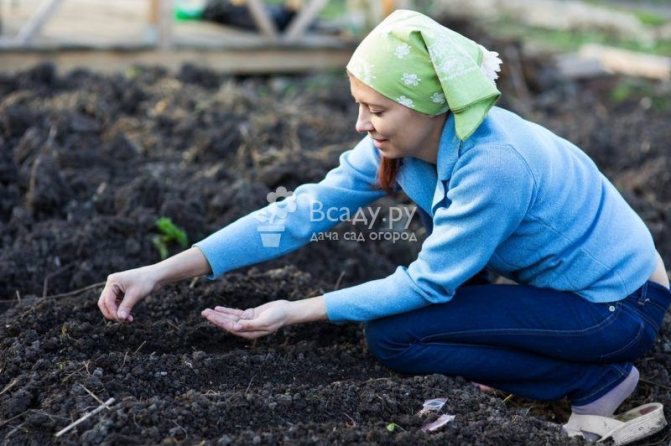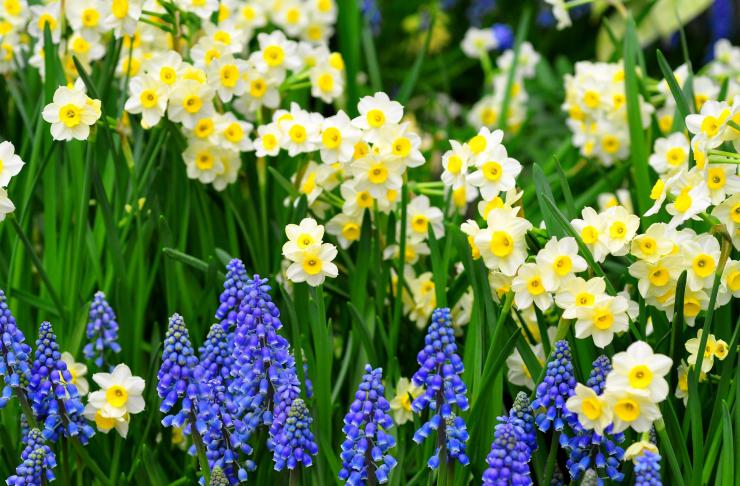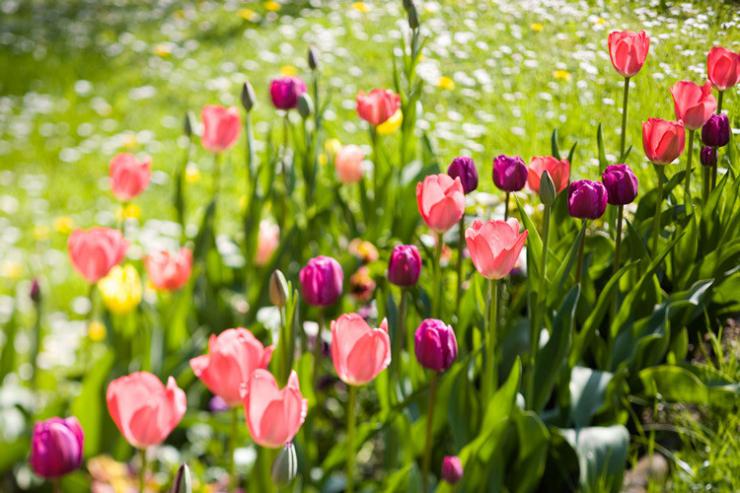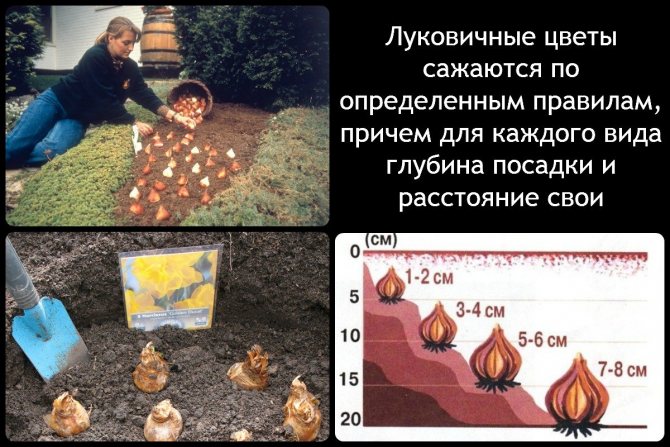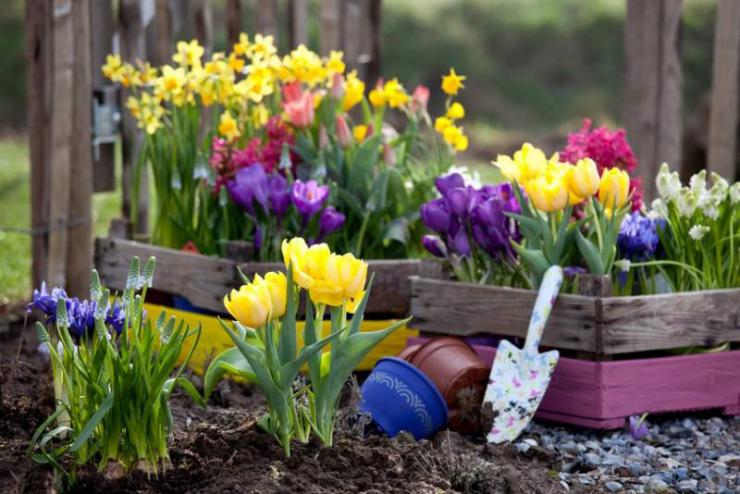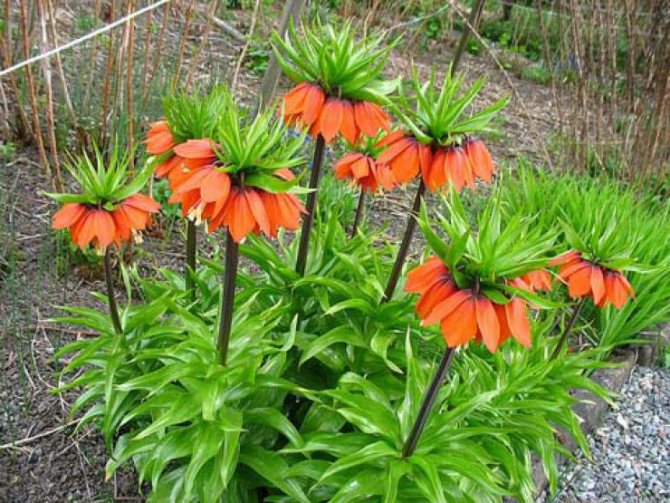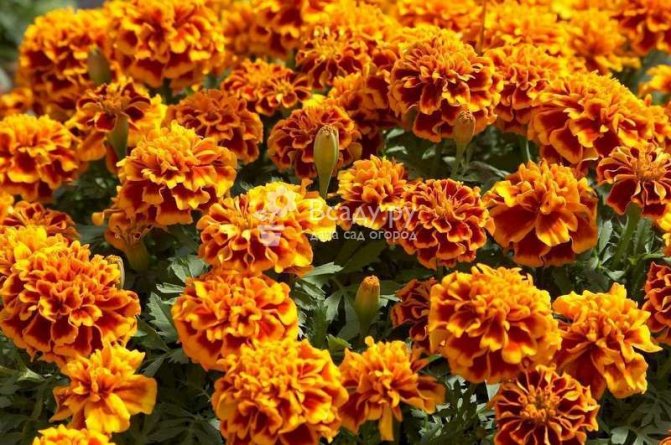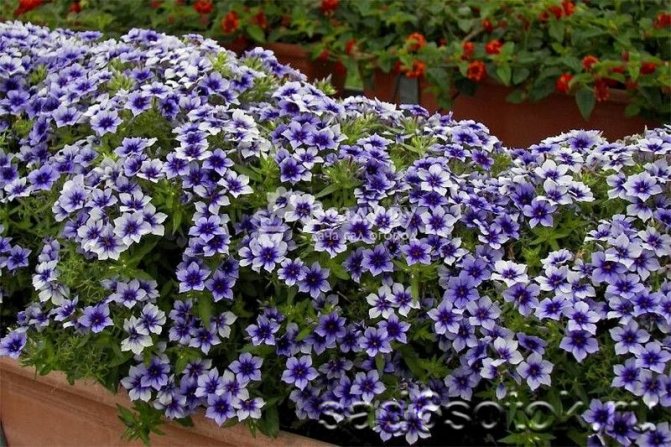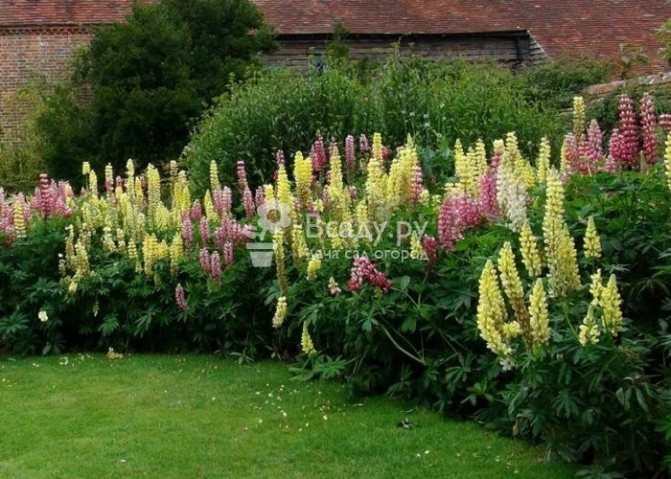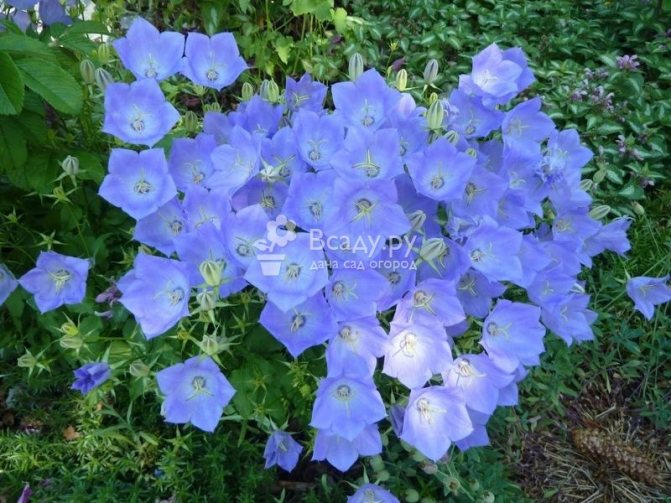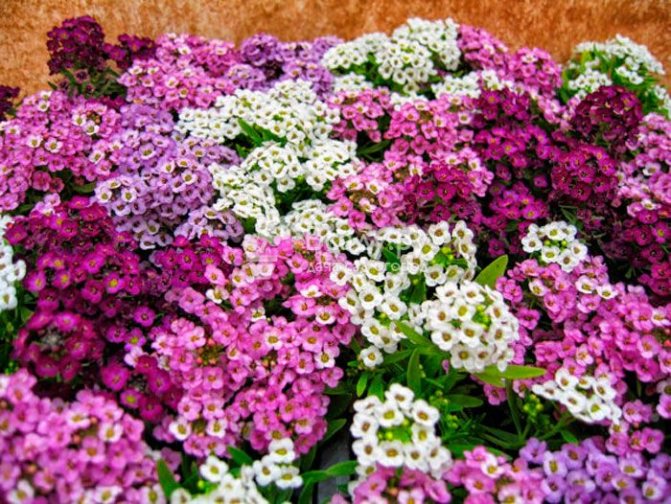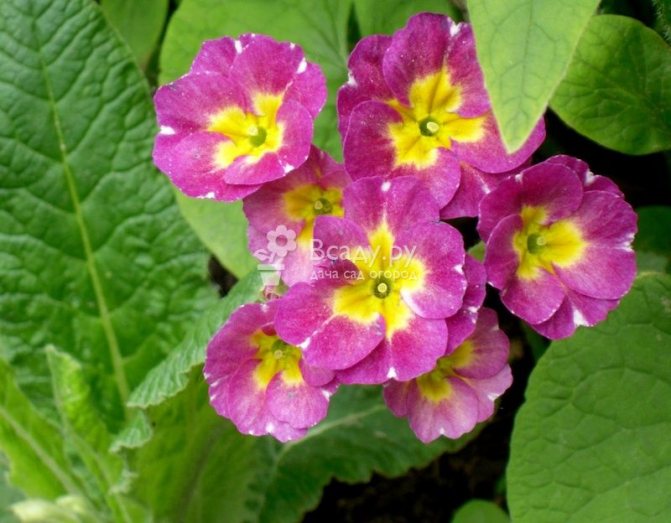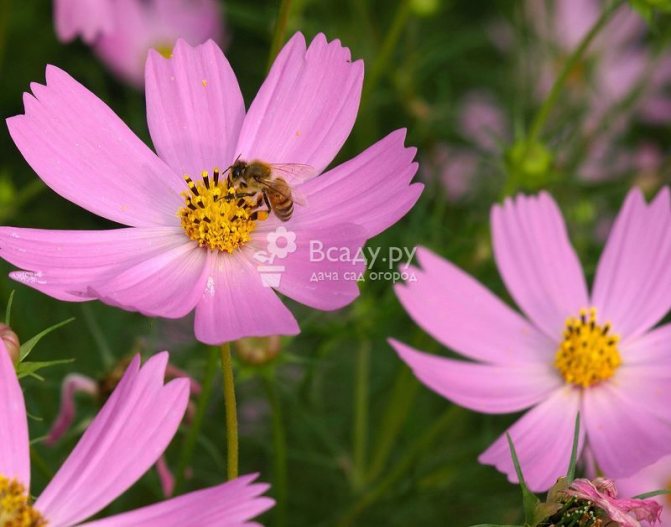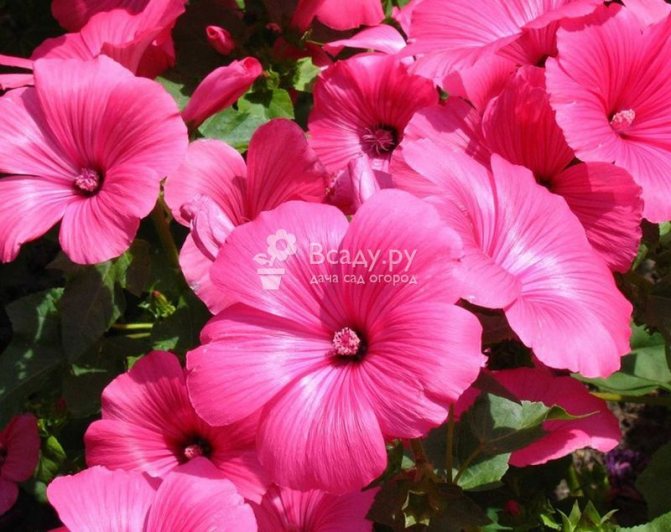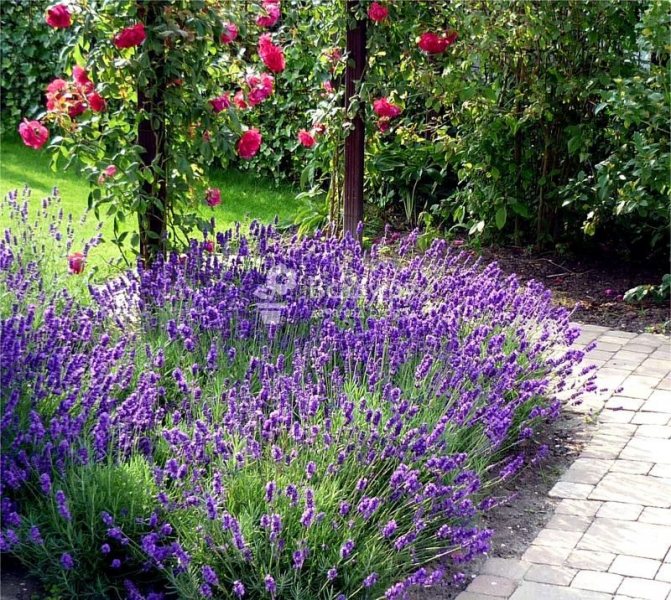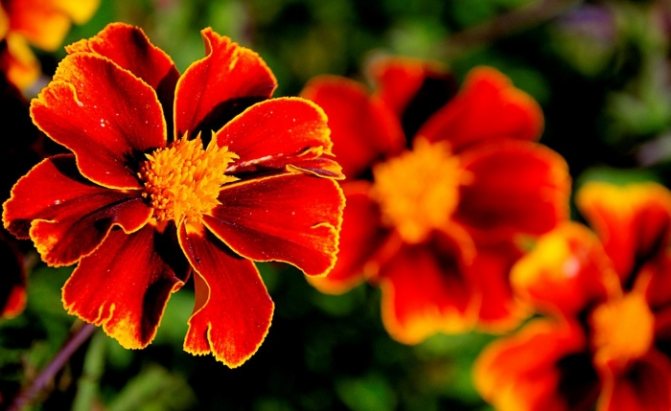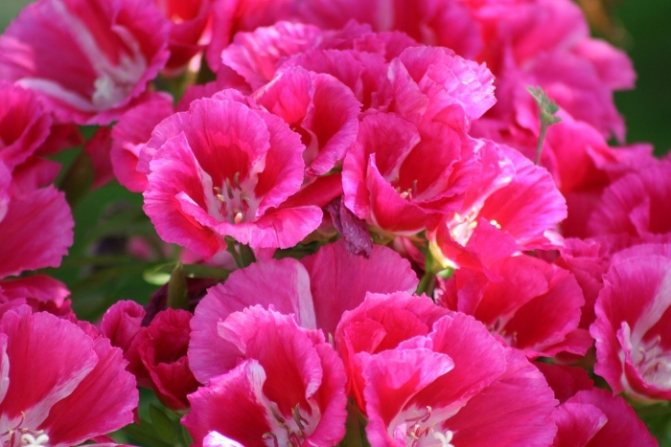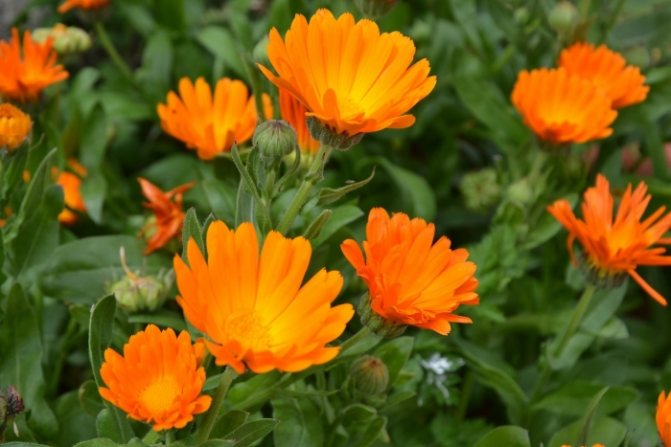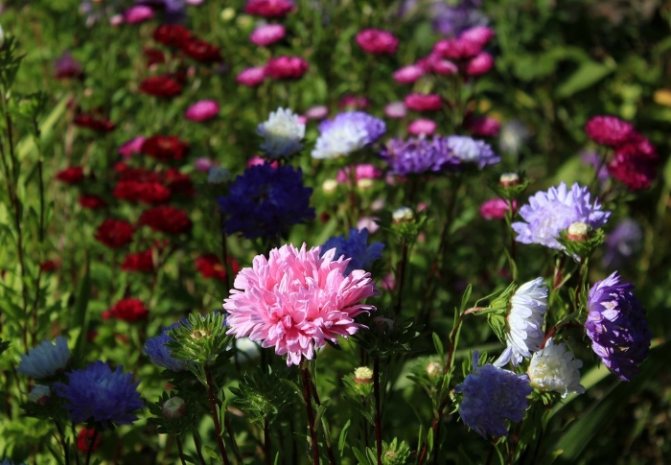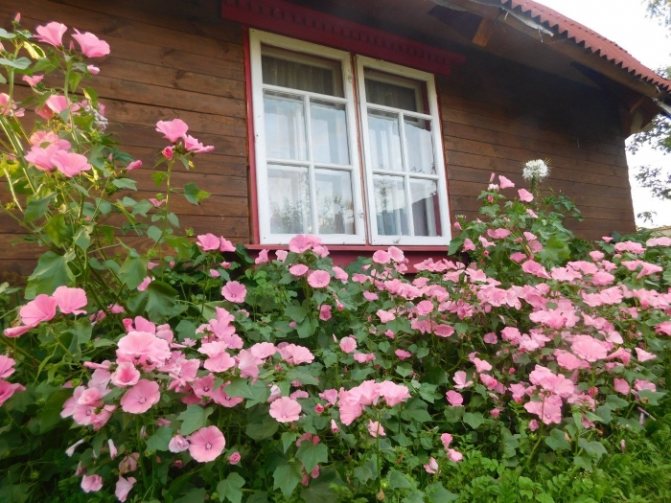1
1901
Garden owners strive to transform their plots every year. Ornamental shrubs, perennial and annual flowers are used. To facilitate your own work, to speed up the opening of buds in the spring and to protect yourself from worries about seedlings, you need to find out what flowers are planted in the fall before winter, and in what sequence this work is carried out.
Hardened flower seeds sprout vigorously
The advantages of planting flowers in autumn
Plants can be planted in the spring, but planting bulbous flowers in the fall provides more benefits:
- Gardeners plant flower bulbs after harvesting and cleaning the garden. These processes are not done in a hurry, but one by one, measuredly. In the spring there is no such possibility, because, in addition to planting flowers, they prepare the ground, grow seedlings.
- Planting material is sold at a discount in the fall. Prices are much higher in spring.
- In autumn, stratification occurs in natural conditions; there is no need to additionally create an imitation of winter cold.
- It is convenient for plants to tolerate planting in cold weather. With the onset of frost, the pests disappear, but the soil remains warm for some time. This helps the plant to take root and develop roots before the ground is frozen deep.
- Bulbous flowers planted in the fall months germinate earlier than others in the spring. They bloom faster too.
- In autumn, heavy rainfall falls, the soil becomes well moisturized and the plants are already in favorable conditions. Due to this, gardeners save themselves from the need for additional watering.
Planting bulbs in spring
Most often bulbous plants need to plant
in the fall, but there are exceptions. If for some reason you did not manage to plant your plant, then keeping the bulb for one more year is, at least, illogical. You can take a chance and plant bulbs
in the spring
when the frosts end. there is
summer bulbs
, which gardeners recommend planting only in spring.
Period for planting
- March and April. In some areas, it can be planted in May.
Bulbous species that can be planted in spring
: calla lilies, begonias, dahlias, gladioli, tigridia and some varieties of lilies.
What bulbous can be planted in the fall
At the end of the gardening season, flower growers divide the shrubs and plant bulbous flowers before winter. These include:
- lily;
- crocus;
- Adonis;
- echinacea;
- astilba;
- pion;
- tulip;
- lupine;
- hyacinth;
- sedum;
- aconite;
- evening primrose;
- rudbeckia.
If the dates for planting bulbs are met, then the flowering of annuals is more abundant and longer. This is due to the natural process of stratification.

Perennial


Among perennials, there are also flowers for which autumn planting is favorable. It is with podzimny sowing that it will be possible to get strong healthy plants with strong immunity. Even those crops that usually bloom in the second year can be presented with buds in the first summer. Here is a list of those perennials that tolerate sowing well before winter:
- aquilegia;
- arabesque;
- Gaillardia;
- geychera;
- gypsophila;
- gentian;
- doronicum;
- Carpathian bell;
- lavender;
- hellebore;
- nasturtium;
- shaved;
- yarrow.
If you observe the timing and technology of planting, the seeds will successfully overwinter in the soil, and in the spring they will start to grow. In summer, all you have to do is admire the beautiful flowers that adorn your garden.
When to plant flowering bulbs
For proper development and thick flowering, corn roots need a cool calm after planting. Therefore, gardeners, starting from mid-August and ending in the second half of September, plant autumn bulbous flowers:
- crocuses;
- hazel grouses;
- daffodils;
- phlox;
- astilbe;
- muscari;
- chionodox;
- rudbeckia.
By the end of September, tulips and lilies are planted. Poor-quality planting material is not recommended to be purchased, it will not germinate. Better to spend more money to buy good stuff in places deemed reliable. If the corn bulbs are collected on their site, then the sick and small ones are rejected, leaving the largest and intact ones.
Attention!
Experienced growers recommend planting flowers at an average daily temperature of about + 5 ° C.
Grouse and fritillaria
Another representatives of liliaceae are not so often found in our flower beds. Orange fritillaria are often confused with lilies. The main conditions for them are soil with good drainage and a lot of sun. The bulb is usually planted at twice its height. These plants are good because they look great both alone and in a group.
Fritillaria and hazel grouse are essentially the same plant. Their variegated color always attracts attention, and drooping flowers look unusual.
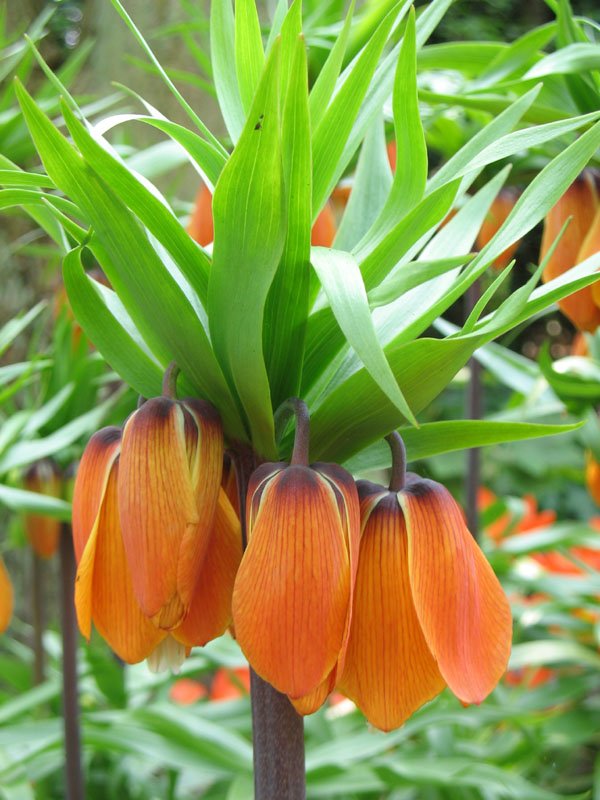

Selection of place and soil
Bulbous plants are planted under trees because they will bloom before the leaves bloom on the branches. In rockeries and rock gardens, Scylla, crocuses, and woodlands fit perfectly.
Bulbous flowers for active growth and abundant flowering need a soil filled with nutrients, in which excess liquid does not linger. If the soil is clay, sand is added to it. Dense, heavy soil must be brought to a normal balance. Before planting, the land is fertilized and watered.


Landing features
Before the autumn planting of bulbous flowers, the tubers are carefully examined. If they find damaged, they are treated with potassium permanganate, and the bruised places are smeared with brilliant green. These activities contribute to the best flowering of future plants. Bulbs that are even slightly rotten must not be planted. They infect the rest of the rhizomes, and as a result, all plants fall ill immediately after planting.
The soil
In the fall, the bulbs strengthen their root system to survive the winter more easily and bloom profusely in the spring. For this, the soil is prepared and nourished. Preparation activities begin a few months before planting. Compost is added to correct the acidity of the soil. Bulbous ones like neutral soils or low acidity. Substances are also added that retain moisture and loosen the soil.
It is not recommended to plant root bulbs in the same place. Bacteria and infectious agents remain in the ground. Even roots treated with fungicides are at risk of infection and death. Therefore, to preserve the bulbs, they are planted annually in a new place.
Bulb planting technology
Depending on what kind of plant gardeners are planting, the planting depth varies. But there is a rule suitable for bulbous flowers that are planted in the fall - the depth should be at least three sizes of the tuber. If the diameter is 2 cm, then a 6 cm layer of earth is poured on top.
A suitable place for planting bulbs is a lawn. The sod layer is removed, and the planting material is placed in the ground. Cover the top with the same turf.
Some types of soil become denser from a lot of rain. In such cases, sand or other lightweight substrate is added to the bulb hole. This must be done so that the depth of the fossa remains the same. In dry autumn, after planting, the bulbs are abundantly watered and mulched. Fallen leaves, sawdust or peat are used as mulch.
A gap of about 15 cm is left between adjacent bulbs.Large rootlets require a greater planting depth. It is achieved by covering with a high mulch layer.
Flowers that are too susceptible to cold and moisture quickly rot. Therefore, the newly planted plants are covered with a greenhouse film on top. But in the spring they remove it on time, otherwise the bulbs are cut out and die.
Advice!
Planting sites are marked with small branches or pegs so as not to make a mistake and not dig up the bulbs in the spring.


Bulb planting rules (video)
Take a close look at the condition of the bulbs before planting them in the ground.
The bulbs must be flat and free from disease and rot.
If any are found, get rid of such bulbs without pity. It is better to lose one or two bulbs than to regret them and re-inoculate all the flowers in the garden. But if there are traces of damage on the bulbs, dip them in a solution of potassium permanganate to carry out disinfection. Damaged places can be treated with brilliant green for a heightened effect.
Prepare a planting site. The top layer of soil must be removed, and fine sand must be sprinkled on the bottom. It is advisable to place the bulbs at a distance of 10-15 cm from each other (usually for large bulbs). Each bulb is pressed to the ground and covered with soil.
If the soil on the site is clay, the best option is to mix the backfill soil with humus or peat.
In addition to good watering of the planting site, mulching must be carried out. Do not forget to mark this place with pegs so that you do not accidentally disturb the bulbs during the spring digging.
The situation is much simpler on loose fertile soil. There is absolutely no need to do drainage, you just need to make a depression in the ground, plant the bulbs at a certain distance from each other and cover them with water.
Pruning bulbous plants
Bulbous plants also need pruning. This stage occurs after the flowering period. Therefore, you need to know the features of the correct haircut:
- after the plants have faded, the ovaries are cut off. This is done so that the flower does not waste energy on the formation of seeds;
- the stems are left because they help store nutrients;
- in dead plants, leaves cannot be cut off or tied so that they dry out faster;
- the bulbs are removed only after the leaves are completely dry.


You may be interested in:
How to save tulip bulbs after flowering until next spring Many people love tulips. Gardeners grow these beautiful flowers in a variety of colors. In July, it's time to dig ... Read more ...
Landing time
On average, a bulb takes root in non-frozen ground in 2 weeks. This is where we should proceed. Surely you already know when it's time for stable frosts. Of course, Mother Nature can sometimes present unpleasant surprises - a thaw after persistent frosts or a sharp onset of winter after a long warm autumn. Don't panic, we have everything under control!
If your bulbs managed to sprout, and then suddenly winter came, they just need to cover
... Lapnik, hay, straw, fallen leaves will do. This does not apply to sprouts and - they winter wonderfully under the snow.
Another variant: frost has come, and you have not yet planted bulbous
... No matter how wild it sounds, you can still plant them: there are several thaws ahead, during which the earth will warm up enough for the bulbs to take root. This can be done if the soil is not frozen to the planting depth. This is the way for those looking for early spring bloom.
If the timing of flowering is not important, plant the bulbs in the spring, they are. The value of the autumn planting of bulbs is that it allows you to get the earliest flowering. By the way, if in the fall plant the bulbs at intervals of 5-7 days
, then in the spring you can get a flower bed that blooms continuously for a month, or even longer! Try it - the result will pleasantly surprise you.Moreover, you can use bulbs of the same type and variety - the planting time will delimit the time of their flowering.
In what months do you need to plant bulbs
Depending on the type of plant, the timing of its subwinter planting varies:
- September. At the beginning of the month, gardeners are engaged in dividing bushes, replanting plants such as solidago, phlox, astilbe. Gardeners plant small-bulb flowers: scillas, pushkinia, crocuses, muscari. Closer to the middle of the month, daffodils are planted, and after 5-7 days - hyacinths. The tulip planting date is the last week of September. It is important to observe the correct timing, because if everything is mixed up, then the plants will not develop a strong root system.
- October. Planting tulips and hyacinths can be postponed until mid-October if winters come later in your climatic conditions. The planting sites of hyacinths are covered with foil so that the soil does not gain more moisture during the autumn rains. "October" tulips are easier to fight viruses. Cold and damp soil is great for these flower bulbs.
- November. If the autumn turned out to be warm, the temperature did not drop below +3 ° C, then tulips are planted in November. But you need to be more careful with this, because if the temperature conditions are not observed, the flowers slow down their growth or even die.
If tulip bulbs are purchased late, then they are planted at home in a special container, so it will be safer for planting material and the plant will not freeze. Proper care in this case is very important, because everything must be done so that they bloom on time. In the spring, a fairly strong grown plant is planted in open ground.


Biennial and perennial flowers that can be sown before winter
Aquilegia
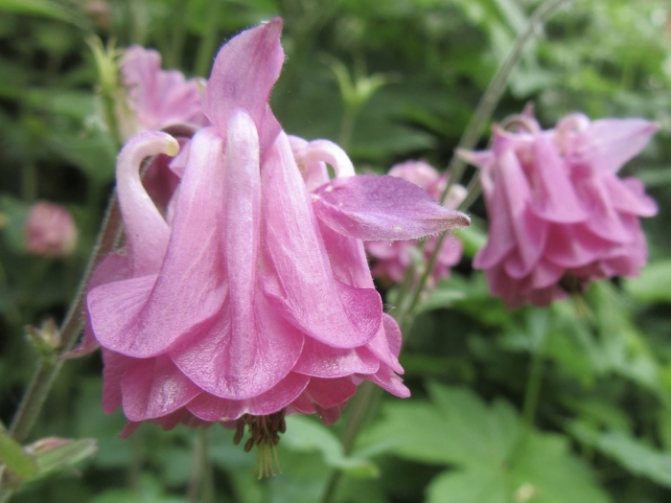

Aquilegia
Aquilegia is a charming plant with delicate foliage. It is widely used for decorating flower beds, borders of ridges, mixborders. It is very popular because of its unpretentiousness.
Seeds of aquilegia must necessarily undergo stratification in cold conditions, therefore autumn sowing is preferable. Aquilegia does not like transplanting, it is better to sow it immediately to a permanent place. The plant prefers partial shade and loose, humus-rich soils. When sowing, the seeds do not need to be deeply buried in the ground, it is enough to sprinkle them a little. The crop bed must be covered with mulch.
Alpine aster


Alpine aster (Aster alpinus)
Growing alpine aster (Aster alpinus) from seeds is not difficult. It can be sown before winter or in spring in May. Autumn sowing is preferable, after stratification under natural conditions, the seeds germinate much better. Aster seeds are small enough, it is better to sow them in boxes or containers, and then dig into the ground. But you can immediately go to a permanent place.
To grow asters, you need to choose sunny places or partial shade. The bed must be in a slightly elevated place. The plant does not grow well in damp or humid places. The crops are sprinkled with a thin layer of humus. It is better to mulch them for the winter.
Badan
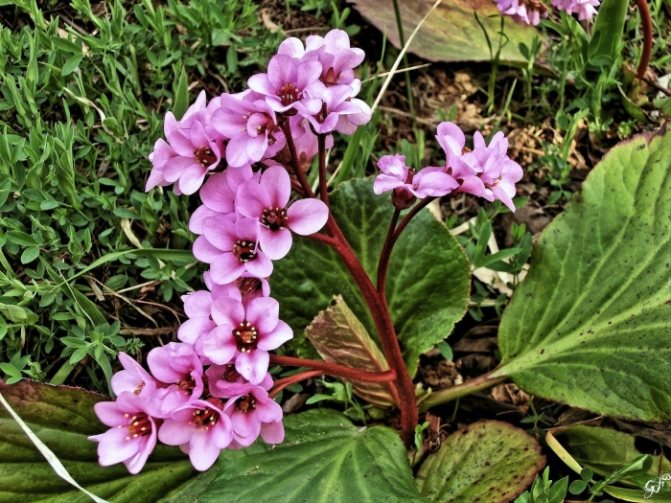

Badan (Bergenia)
The process of growing bergenia (Bergenia) from seeds is not easy. Seeds need cold stratification for germination, and in spring they need to be at a certain temperature. Seeds and seedlings are very small, besides, seedlings develop rather slowly. For this reason, when sowing badan seeds, it is important to adhere to a certain technology:
- seeds before sowing must be treated with a fungicide for the prevention of diseases, for example, "Fitosporin";
- sow seeds in boxes with loose soil to a depth of no more than 0.5 cm;
- The seed box will need to be kept outdoors, under the snow. Thus, seed stratification will take place.
In the spring, at the beginning of March, the boxes need to be brought into a room where the seeds will germinate at a temperature of 18-19 ° C for about a month.Crops should be kept in a bright place, but not in direct sunlight.
As shoots appear, you need to monitor the moisture content of the soil. The soil should not be dry or excessively wet. Seedlings develop very slowly, they can be cut into pots when they reach a height of 10-12 cm. Plants will bloom for 3-4 years.
Gypsophila


Gypsophila
Gypsophila (Gypsophila) tolerates transplanting very badly, it must be sown immediately to a permanent place. In one place, gypsophila can grow for a very long time, so it is important to immediately choose the right one for them. Plants grow strongly over the years, so the gypsophila is located quite freely - 2-3 plants per square meter.
For sowing, you need to pick up an open, sunny place, preferably with loose sandy loam soil. If the soil is dense, be sure to add small pebbles and sand to it. The site must be dry enough, without stagnant water - gypsophila can die with strong moisture.
Heuchera


Heuchera
Heuchera reproduces well by seeds, but it must be borne in mind that seeds do not germinate for so long. Heuchera seeds and shoots are very small, so sowing and caring for seedlings can be quite troublesome. It is more convenient to sow Heuchera in boxes with loose, well-drained soil. The soil should not be acidic. The seeds do not need to be buried, it is enough to press them down a little.
Gentian
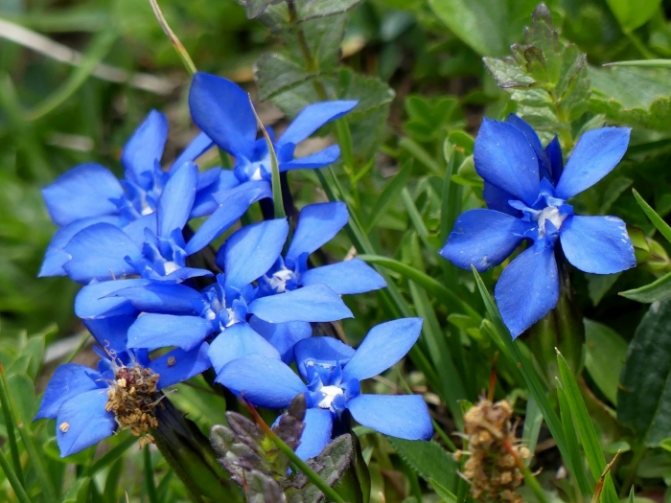

Gentian (Gentiana)
An interesting plant for rocky hills, rock gardens. Gentians (Gentiana) are not yet very common in flower beds, possibly due to the fact that they are not easy to grow from seeds. To get gentian seedlings, you need to know that it needs long-term stratification in cold conditions. Under the influence of temperature extremes, soil moisture in the seeds, processes occur that promote their germination.
It is better to sow gentian in boxes or pots with loose soil. Sprinkle the seeds with a layer of soil and bury the containers in the ground in a shady place. In the spring you need to make sure that the soil in them does not dry out.
Gentian sown in autumn, as a rule, germinate in May - June. It also happens that the seeds that did not sprout in the spring sprout the next year. Therefore, do not rush to throw the earth out of the boxes. The boxes should be kept in partial shade and the soil should be kept moist. And in winter, leave them on the street again.
Delphinium
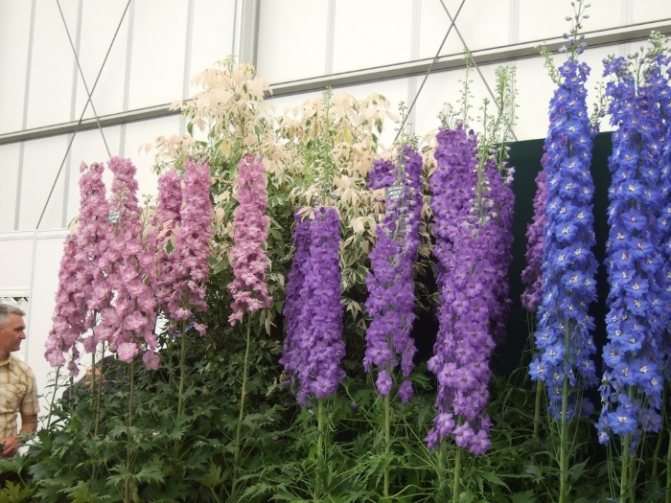

Delphinium
Growing a Delphinium from seeds is not easy. When sowing, be sure to consider the following:
- the delphinium needs cold stratification, therefore, it is preferable to sow it before winter;
- only fresh delphinium seeds germinate well. If planting is postponed until spring, then the seeds must be stored in the refrigerator;
- they can only be sown in light, loose soil. In heavy clay soil, they usually do not emerge.
Delphiniums do not tolerate transplanting well, so it is advisable to sow them immediately to a permanent place. For sowing, you need to choose a sunny, wind-protected flower bed. Seeds are not sown deeply, by 2-3 mm, crops for the winter need to be covered with mulch.
Carpathian bell
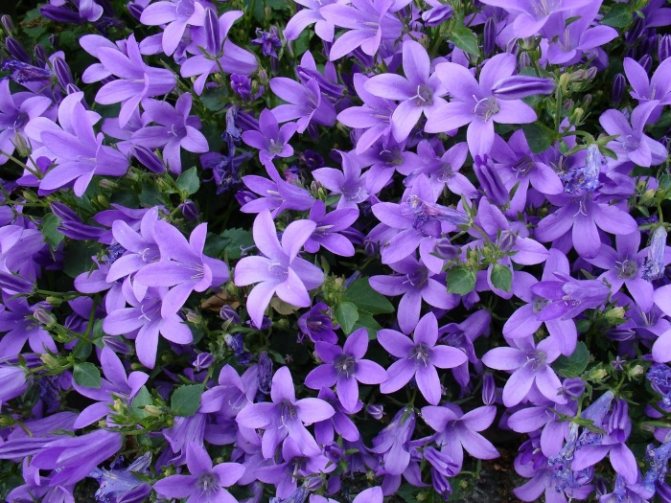

Carpathian bell (Campanula carpatica)
Usually the Carpathian bell (Campanula carpatica) is sown just before winter. A well-lit place is selected for sowing. The soil is preferable well-drained with an acidity close to neutral.
Soil preparation is standard, it consists in digging and fertilizing. Humus and sand are introduced into heavy soil. If the acidity is high - lime, dolomite flour or ash.
Lavender
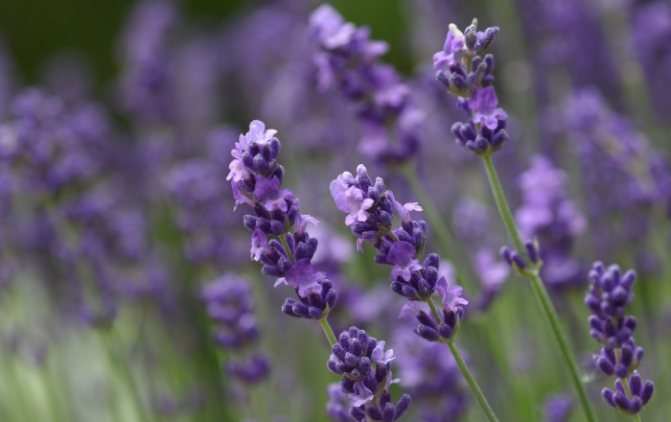

Lavender (Lavandula)
Lavender (Lavandula) is a very attractive plant, but quite whimsical when grown from seed. If you are having trouble getting her seedlings to germinate, try sowing lavender before winter. The thing is that she definitely needs to go through the stage of cold stratification. If sowing in the spring, you will have to place the seed bowls in the refrigerator.
For sowing lavender in open ground, you need to choose a sunny, wind-protected place, always dry, without stagnant water. The soil for growing lavender should be loose and fertile. The plant does not grow well on acidic soils, therefore, with increased acidity, lime or wood ash must be added in advance.
When planting, the seeds do not need to be buried too deeply into the soil, by about 3-4 mm. You can sprinkle the grooves with seeds with river sand. After sowing, the garden bed must be mulched for the winter, and with the onset of stable frosts, throw more snow over the bed.
Usually shoots appear in May – June. Seeds can sprout later, so you don't need to try to dig up the garden too early. When the seedlings appear, you need to control the watering - the soil should be moist, but not flooded with water.
Lupine
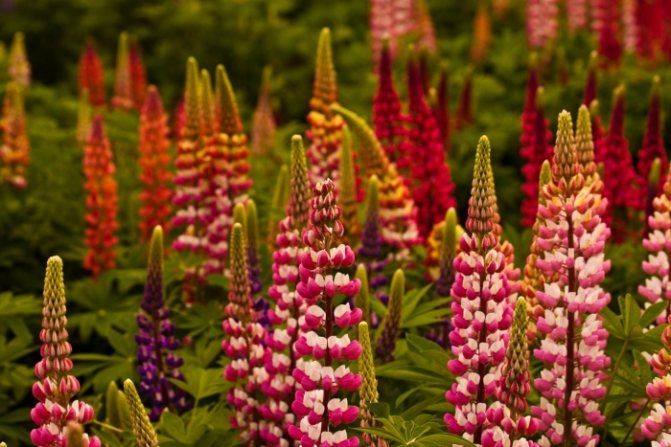

Lupine (Lupinus)
Perennial lupins (Lupinus) are not only a bright flower bed decoration, but also a valuable green manure plant. Although, usually, like green manure, they sow annual lupine. Unlike spring sowing, when sowing before winter, seeds give amicable shoots.
It is better to sow lupine immediately to a permanent place. When sowing, the size of adult plants must be taken into account, the seeds must be planted at a distance of at least 25-30 cm. For sowing, it is advisable to choose a sunny place or partial shade, soil with an acidity close to neutral. The plant does not tolerate the close occurrence of groundwater.
Primrose


Primula (Primula)
Getting a primrose (Primula) from seeds is not very easy, not every grower succeeds. Seeds of primrose require stratification, so sowing it before winter is desirable. It should be borne in mind that seed germination is quite low, especially if the seeds are not just harvested. The seeds of the flower are small, and the seedlings are very small at first. Therefore, it is recommended to sow it not in a garden bed, but in a separate box.
Before sowing, the soil must be very carefully prepared. If the soil in the area is very dense, it will be difficult for small seedlings to break through. Therefore, the soil must be loose, well-drained. You can even stock up on good store soil for primrose sowing. This soil will not contain weed seeds. And as a rule, ready-made soils of good quality are very loose and light.
Seeds of primrose are sown superficially, slightly falling asleep with soil. It is better to put a box with crops in partial shade so that the spring sun does not burn tender seedlings. It is necessary to carefully monitor the moisture content of the soil. Small seedlings can die even with a short-term drought, and with an excess of moisture, they can suffer from waterlogging. Primrose seedlings develop rather slowly. And all this time crops need careful care.
Nivyanik, or "garden chamomile"
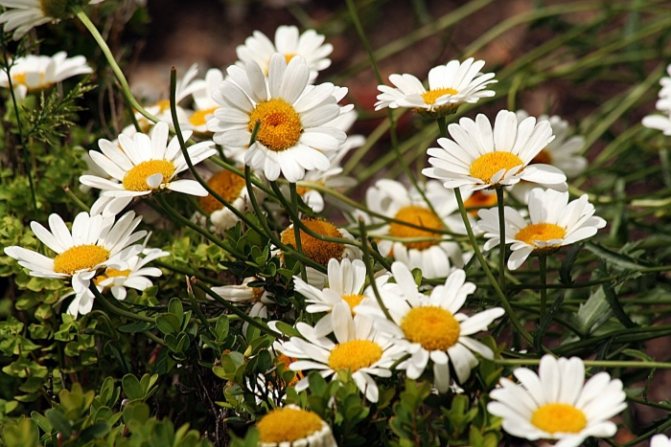

Nivyanik (Leucanthemum)
Seeds of leucanthemum (Leucanthemum), or garden chamomile, as gardeners often call this flower, are distinguished by good winter hardiness, they can be sown both before winter and in early spring. With this sowing, the entrances will be stronger and hardened.
The preparation of the beds and the soil for sowing is standard, you can sow the cornflower on the seedling bed, or you can immediately at a permanent place.
Dear Readers! In addition to the plants listed above, you can sow aconite, arabis, buzulnik, gailardia, helenium, doronicum, saxifrage, clematis, levisia, flax, lychnis, euphorbia, obrieta, sedums, rudbeckia, garden yarrow before winter. From biennial flowers - mallow, daisy, forget-me-not, Turkish carnation.
As you can see, the list of flowers that can be grown by sowing before winter is quite large. Sowing under winter gives undeniable advantages, especially sowing perennials.
And it’s also convenient. Therefore, try, if in doubt, sow some of the seeds in the fall, the other in the spring.
Overview of florist preferences and the most popular varieties
Different varieties of bulbous need a certain type of soil, the amount of sunlight and moisture. The planting depth also differs. Conditions for the most popular varieties:
- Muscari.Loose, drained soil is suitable for these flowers. Muscari love sunny places, so they are not planted in the shade. The bulbs are buried to a depth of 8 cm with an interval of 10 cm between the plants.
- Crocuses. These flowers love permeable earth and sunlight. They are planted in the same way as muscari.
- Daffodils. Plants bloom well both in the sun and in the shade. Moisture-permeable soil is suitable for them. Planting dates are August-October.
- Tulips. These flowers are the most unpretentious among the bulbous. They do not need special conditions, but at the same time their diversity is amazing. The varieties differ from each other not only in color, but also in shape. They are distinguished by the longest autumn planting period and the possibility of home distillation.
- Lilies. The soil for planting lilies is fertilized and drained. Different varieties require their own conditions for planting.
- Grouse, fritillaria. Sunlight and drained soil are important for these flowers. They are planted with an interval equal to two sizes of the bulbs. Plants of orange color are visually very similar to lilies.


You may be interested in:
Gladiolus bulbs: preparation for planting Proud and luxurious gladioli, how they decorate our garden! They glow like candles against the background of greenery of other foliage, shining with different ... Read more ...
Planting bulbous irises
Bulbous irises
- these are very bright and beautiful flowers. They can often be found not only in gardens and parks, but also in city flower beds, near residential buildings and recreation areas. Irises are rarely cut off, so it is appropriate to plant them in big cities.
Irises bloom
most often in May and also in June.
Before boarding, you should check
bulbs, they must be healthy. Some flower lovers
process
bulbs before planting with fungicides. Right
choose soil
... Irises do not like stagnant moisture and dampness; it is better to choose dry soil than very wet soil. It is better to take ready-made soil for irises or ordinary black soil. Before planting, it is recommended to fertilize the soil.
Remember!
Irises do not like anything superfluous. Strongly rich soil will not suit them; abundant watering and frequent fertilization are also detrimental. It's best to be in time
plant irises in September
, then already in the first spring they will delight with their colors.
Plant
irises, like other bulbous plants, we wrote about planting above.
When is the best time to buy bulbs
The best option is to purchase the plant bulbs shortly before the planting process. But this does not always work, because summer bulbs are sold only in winter. That is, they must be properly stored until the moment of disembarkation. The planting material purchased ahead of time is placed in peat or sand and stored in a room with a temperature of about 5-7 ° C.
Advice!
Experienced flower growers recommend not taking spring flower bulbs before warming. When stored in a warehouse, the shelf life of such planting material will already expire by spring.
Algorithm for planting flower bulbs in autumn
Before planting, the bulbs of spring flowers must be sorted out, discarded damaged ones, and treated with a fungicide. It is important to remember that large bulbs will produce large flowers and vice versa. Consider this when planning your planting so that the aesthetics of the flower garden are not compromised.
Planting plan for bulbous flowers:
Remove weeds from the future flower garden. There is no need to loosen the soil. Make holes in predetermined places using a special device or glanders. Calculate the depth using the following formula: if the ground is light - 3 bulb heights, if heavy - 2. Specify the planting density for each variety of flowers separately.
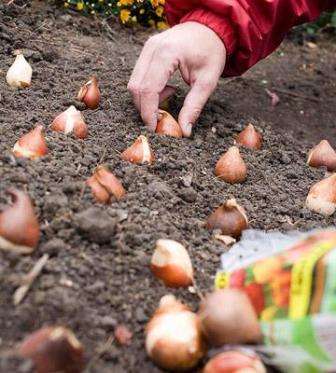

Planting density depends on the variety of flowers
Place the flower bulb with the bottom down, sprinkle with earth and compact a little. If the soil is too dry, lightly moisten each hole.
Planting Bulbous Flowers for Winter Bloom - Forcing
Forcing is a process aimed at obtaining buds by a certain period. This is achieved by accelerating the imitation of three natural stages: a period of rest, cooling and awakening. By calculating and implementing each stage correctly, you can achieve the flowering of your favorite plants in a certain period of winter.


Algorithm for forcing bulbous flowers at home:
1. Prepare large, healthy bulbs for distillation. In the flower shop, you will be offered material specially prepared for this. 2. Treat the planting material with a potassium permanganate solution or a suitable fungicide. If the purchased bulbs have passed this step before they go on sale, you can skip this step. 3. Plant in wide, low containers with a drainage layer at the bottom and holes to allow water to drain out. Soil: sod land + humus + sand. Large bulbs are not sprinkled completely, small ones are sprinkled on top with a layer of 1-3 cm. After watering, the containers are covered with an air-permeable opaque material.
Forcing bulb flowers begins with autumn planting
4. Place the containers with the planted bulbs in a cool place (+ 4-8 ° C) for 10-14 weeks. It is better not to allow the soil to completely dry out during this period. 5. Move the pots to a lighter and warmer place (10-15 ° C) when the planned wake-up time comes. 6. Bring the flowers into the living area and place them on the window when the buds begin to take on their characteristic color. It is better to put them in a cooler place at night.
Eschsholzia
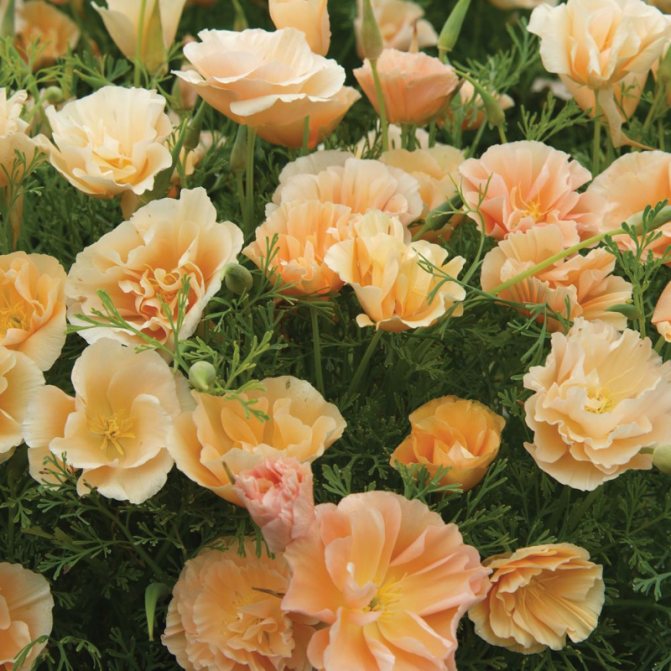

Eshsholzia is a member of the poppy family. In the wild, there are about 10 species of this plant.
For sowing, you need to choose a well-lit area with dried soil. The seeds of the escholzia are small, so they should be lightly planted in the ground. After sowing, it is necessary to regularly loosen the soil and fertilize with peat. Watering is carried out as the soil dries up.
The technology of winter sowing of annuals in a container
- The containers should be shallow (7-10 cm) and have drainage holes.
- Substrate - to be loose, moisture and air permeable and moderately nutritious. The optimal soil mixture consists of garden soil, peat and coarse river sand or vermiculite (1: 3: 3).
- Drainage is poured onto the bottom of the container with a layer of 2 cm. A layer of soil mixture 4-6 cm thick is compacted, the dry soil is slightly moistened. The rest of the substrate is left in a frost-free room for backfilling the sown seeds.
- Prepared containers are placed in the garden in trenches or pits 15-20 cm deep more than the height of the container. This difference is filled with drainage poured onto the bottom, and the gaps between the placed containers and the edges of the trench or pit are covered with leaf litter.
- Cover the top of the container with foil.
- As soon as the sowing time has approached, the film is removed from the containers, the seeds are distributed evenly over the soil surface and covered with the remaining soil mixture. The thickness of the layer depends on the size of the seed (see above).
- From above, the crops are mulched with leaf litter, which is harvested after the spring thaw of snow. In the spring, crops are thinned twice: at the stage of the first pair of true leaves, then two weeks later, observing the distance between the seedlings for a particular plant species.
- In late May - early June, plants are planted in a flower garden.
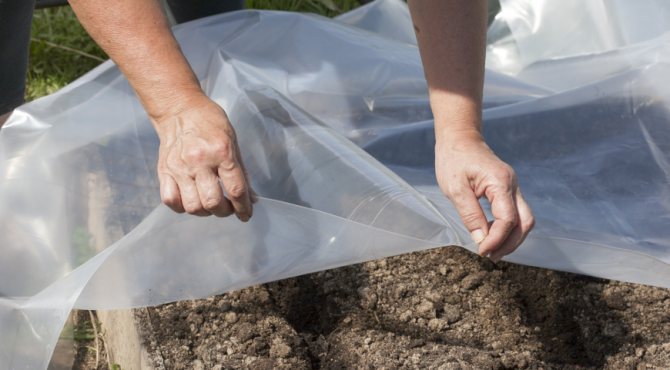

In the photo: Preparing the site for winter sowing
Aster annual
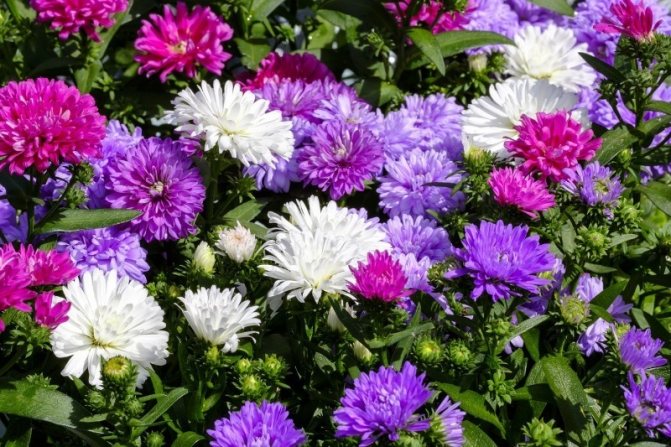

Annual aster is a genus of herbaceous plants of the Astrov family, which was introduced into cultivation in the middle of the 19th century. In nature, there are about 4 thousand varieties of asters, differing in color and shape of inflorescences.
Asters are a light-loving plant, therefore, when sowing, you need to pay attention to the planting site. During the growth period, the flower needs fertilization and loosening.
When to sow seeds outdoors
Sowing seeds before winter should be carried out only with the onset of stable frosts. If you hurry and plant early, the seeds can germinate and die in the cold. The optimal time for planting is at the end of October.In some regions with warm climates, a thaw is likely even in late autumn, and it is better to postpone sowing until mid-November. It is necessary that the open ground is frozen to 4 degrees, and the air temperature during the day drops below 0 degrees.
Video "When to sow seeds before winter"
Kosmeya


Kosmeya is an annual herb native to Latin America. There are more than 20 species of this flower, but in Russia three of its varieties are most often grown: double-feathery, gray-yellow and blood-red cosmos.
Kosmeya tolerates drought well, so watering it is enough only once a week. Fertilizers should be phased: during growth, during budding and during flowering itself.
Useful tips for flower growers
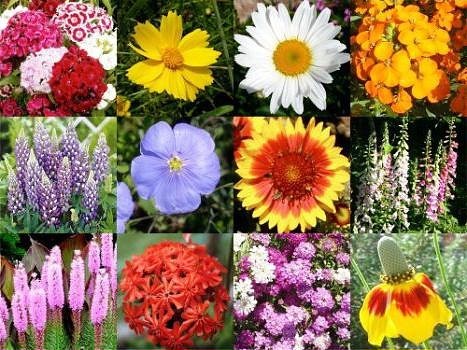

Winter sowing allows you to identify the quality of the seed. If seedlings are too rare in winter, you can always buy seeds and grow additional plants from them using spring sowing. Here's what else you can do to ensure that the winter sowing of annual and perennial crops is fully justified:
- It is better to sow most annuals in a flowerbed immediately, removing excess seedlings in spring, since they are sensitive to transplanting, and it can delay their flowering.
- It is better to grow asters on a school, covering them with a film in the spring, and then transplant them to a permanent place.
- If, immediately after the snow melts, you install metal arcs above the flower bed and cover them with a film, flowering can be obtained even earlier by 1-2 weeks.
- During spring diving, it is necessary to observe the distance between shoots recommended for this crop. If the planting is too thick, the plants can hurt and bloom worse.
- When planting perennial asters on a flower bed, please note that tulips, gladioli and carnations are not recommended as predecessors for these flowers. But they can be safely planted after tagetis and calendula.
- When choosing a composition, take into account the plant's moisture needs. Flowers that require abundant watering and those that prefer drought should not grow nearby. Plants in a flower garden should also match in color.
- You can make podzimny sowing flowers in separate containers, which are then dripped into the soil. This method replaces the use of a school and prevents the seeds from being washed out by melt water. You can later transplant these plants wherever you want. Pot holes should also be prepared in advance, they should be of the appropriate size.
In the southern regions of Russia, winter sowing of the following annuals is effective:
- Large antirrinum (snapdragon): seed size is small, planting pattern is 20 x 30 cm.
- Bidense ferulele: the seed size is average. Planting pattern: 30-35 cm between nests, 3-4 seeds per nest.
- Godetia grandiflorum: the seed size is small, the planting pattern is 15 x 20 cm. A painless transplant is possible only at a young age.
- Sander Tobacco: seed size is small, planting pattern is 20 x 30 cm.
- Chrysanthemum keeled, sowing chrysanthemum: the size of the seeds is large. The nests are arranged according to the scheme 25 x 25 cm or 30 x 30 cm, 3-4 seeds per nest.
- Marsh chrysanthemum: the seed size is average. Nests are arranged according to the scheme 20 x 20 cm or 25 x 25 cm, 3-4 seeds per nest.
Iberis
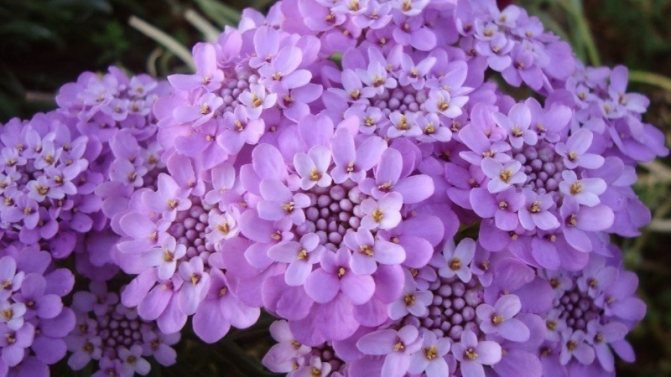

Iberis is a herb of the Cabbage family. In the garden, the plant is used for bordering lawns and flower beds.
Iberis practically does not require maintenance, therefore, when growing, there is no need to heavily flood the soil and cover it with an additional layer. The only problem that can be faced is the formation of root rot. To avoid this, it is necessary to plant the culture among the stones.


